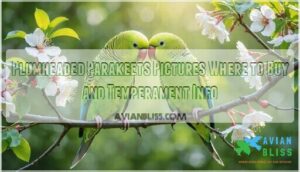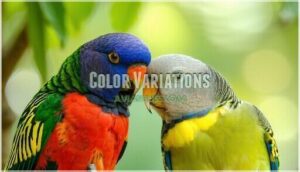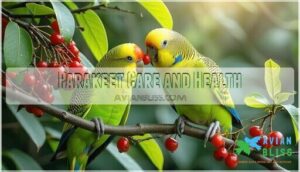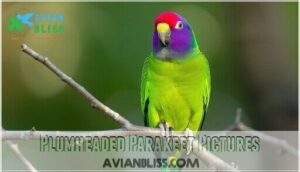This site is supported by our readers. We may earn a commission, at no cost to you, if you purchase through links.

These charming birds display gentle, intelligent temperaments and bond deeply with their owners, making them wonderful companions for patient bird enthusiasts.
You can buy plumheaded parakeets from certified avian breeders, reputable pet stores, or rescue organizations, with prices typically ranging from $200-500.
They’re social creatures who thrive on interaction and can learn basic tricks with consistent training, and their calm nature makes them suitable for families.
Though they require daily socialization to prevent behavioral issues that many first-time owners don’t anticipate, with proper care, they can make wonderful companions and their ability to bond deeply is a notable characteristic.
Table Of Contents
- Key Takeaways
- Plumheaded Parakeet Overview
- Parakeet Temperament Info
- Buying Plumheaded Parakeets
- Parakeet Care and Health
- Plumheaded Parakeet Pictures
- Frequently Asked Questions (FAQs)
- How much does a plum-headed parakeet cost?
- What is a plum-headed parakeet?
- How do I find a plum-headed parakeet?
- How to care for a plum-headed parakeet?
- Are plum-headed parakeets healthy?
- Are plum headed parakeets Hardy?
- What is the temperament of a plum-headed parakeet?
- What is the friendliest type of parakeet?
- What is the lifespan of a plum-headed parakeet?
- How long do plumheaded parakeets live?
- Conclusion
Key Takeaways
- You’ll recognize plumheaded parakeets by their striking emerald-green bodies and distinctive plum-colored heads, with males displaying vibrant purple-red coloring while females show elegant blue-gray tones.
- You can find these birds through certified avian breeders, reputable pet stores, or rescue organizations, with prices typically ranging from $200-800 depending on age and source.
- You’ll discover they’re gentle, intelligent companions who bond deeply with their owners but require daily socialization to prevent behavioral issues and thrive on consistent interaction.
- You’ll need to provide proper care including balanced pellet-based nutrition, regular exercise outside their cage, and routine veterinary checkups to ensure their 15-20 year lifespan.
Plumheaded Parakeet Overview
You’ll find that plumheaded parakeets are medium-sized parrots measuring 13-14 inches long and weighing just 2.3-2.8 ounces, making them an ideal choice for bird enthusiasts who want a colorful companion without the space requirements of larger parrots.
Looking for a vibrant feathered friend that won’t take over your living room? Plumheaded parakeets deliver stunning colors in a perfectly manageable size.
These striking birds showcase distinct gender differences, with males displaying vibrant purple-red heads and females featuring elegant blue-gray coloring, both complemented by their mostly green bodies and distinctive black neck collars, which are key characteristics of these medium-sized parrots.
Physical Characteristics
When you’re admiring a plumheaded parakeet, you’ll notice these medium-sized birds measure 13-14 inches with distinctive sexually dimorphic plumage.
Males showcase brilliant purple-red head markings, while females display bluish-gray coloring.
Their green bodies feature subtle plumage differences, with identifying features including white-tipped tails reaching 8.7 inches.
Weight variations range from 2.3-2.8 ounces, making size comparison straightforward.
Color Variations
You’ll notice striking differences between male and female plumheaded parakeets.
Male plumage features vibrant purple-red heads with black neck collars, while female plumage displays subtle blue-gray heads with yellow-tinged neck feathers.
Regional differences exist across their native range, and hybrid colors occasionally appear.
Color mutations in plumheaded parakeets are rare but documented, creating unique plumhead mutations that fascinate bird enthusiasts and breeders alike.
Size and Weight
Plumheaded parakeets reach their full plumhead size at maturity, measuring 13-14 inches from beak to tail.
These medium-sized birds typically weigh between 2.3-2.8 ounces, though weight fluctuation occurs based on diet and season.
Here’s what you’ll notice about their average dimensions:
- Length spans 33-35 centimeters total
- Tail alone measures 8.7 inches
- Wingspan reaches approximately 14 inches
- Sexual dimorphism affects head coloring, not size
Parakeet Temperament Info
You’ll find that plumheaded parakeets are gentle, social birds that form strong bonds with their owners while remaining somewhat cautious around strangers.
These intelligent parrots require regular interaction to maintain their friendly nature, and they’re known for being relatively quiet compared to other parrot species, making them suitable companions for apartment living.
Socialization and Bonding
Your plumheaded parakeet’s social nature means they’ll bond deeply with consistent owner interaction.
These birds can become aloof with strangers but remain affectionate with trusted humans.
Adolescent bluffing phases involve temporary aggression that passes with maturity.
Building trust requires patience since they prefer shoulder perches over cuddling for bird companionship.
| Bonding Stage | Time Required | Key Behaviors |
|---|---|---|
| Initial Trust | 2-4 weeks | Cautious observation, gradual approach |
| Active Bonding | 1-3 months | Shoulder sitting, gentle vocalizations |
| Strong Bond | 3-6 months | Seeking attention, protective behavior |
| Mature Relationship | 6+ months | Deep affection, consistent interaction |
Training and Intelligence
Your plumheaded parakeet’s sharp mind makes trick training a rewarding experience.
These intelligent birds excel at puzzle solving and demonstrate impressive learning speed when you’re consistent.
While their talking abilities aren’t as advanced as larger parrots, they master vocal mimicry of short whistles and phrases.
Their cognitive abilities shine through plumhead training sessions that challenge their natural bird intelligence.
Behavior and Personality
Your plumhead’s personality shines through their gentle, affectionate nature with family members.
While parakeet sociability develops strongly with owners, they remain cautious around strangers.
Here are key behavioral traits to expect:
- Adolescent bluffing – Hormonal teenage phase with temporary aggression
- Vocalizations – Relatively quiet compared to other parrots
- Playful behavior – Energetic exploration and curiosity
- Bonding preferences – Shoulder perching over cuddling
- Bird behavior – Peaceful coexistence with other species
Buying Plumheaded Parakeets
You’ll find plumheaded parakeets through reputable breeders who health-test their birds, rescue organizations that specialize in parrots, or adoption centers looking to rehome these gentle companions.
Research your source carefully since hand-fed babies from experienced breeders typically adjust better to family life, while rescued birds may need extra patience but can form equally strong bonds with their new owners, which is a gentle companions aspect to consider.
Reputable Breeders
Finding reliable parakeet breeders requires careful research.
Look for breeders who maintain excellent aviary conditions and provide health guarantees for their plumheaded parakeets.
Quality breeding practices include proper lineage documentation and transparent breeder ethics.
When buying plumheaded parakeets, reputable breeders will answer questions about their birds’ backgrounds and offer ongoing support for new owners seeking plumhead for sale.
Rescue Organizations
Beyond purchasing from parakeet breeders, rescue organizations offer meaningful alternatives for plumhead for sale seekers.
These rehabilitation centers address ethical concerns while providing fostering parakeets opportunities.
Bird adoption through rescue benefits both you and birds needing homes.
Parakeet adoption connects you with organizations specializing in plumheaded parakeet rehabilitation.
Many rescued birds simply need loving families after previous owners couldn’t continue care, and through rescue they can find new homes.
Adoption Process
When you’ve chosen a rescue organization, you’ll start the application process by filling out detailed forms about your bird experience and living situation.
Most groups require a home visit to check your cage setup before approving adoption.
Adoption fees typically range from $50-200, covering veterinary care.
Many rescue organizations offer post-adoption support to help your plumheaded parakeet settle smoothly into their new home.
Parakeet Care and Health
Proper care guarantees your plumheaded parakeet lives a healthy life spanning 15 to 20 years, requiring attention to diet, exercise, and regular health monitoring.
You’ll need to provide balanced nutrition beyond seeds alone and watch for common issues like respiratory infections to keep your feathered companion thriving with proper care.
Diet and Nutrition
Your plumhead’s wild diet consisted mainly of fruits and seeds, but captive bird nutrition requires more balance.
A quality pellet-based bird food should form the foundation, supplemented with fresh vegetables and fruits.
Avoid seed-only diets and toxic foods like avocado or chocolate.
Consider pellet food options for balanced nutrition.
Establish a consistent feeding schedule with proper portions to prevent obesity while meeting their supplement needs for peak health.
Common Health Issues
Your plumhead’s health depends on recognizing warning signs early.
These birds face several common ailments that require prompt attention from an avian veterinarian:
- Respiratory Infections – Watch for difficulty breathing and wet droppings
- Parrot Fever – Often linked to poor seed diets lacking nutrition
- Scaly Mites – Affects skin around legs and eyes
- Hypovitaminosis-A – Causes thickened, infected membranes
Exercise and Enrichment
Your plumheaded parakeet needs daily flight time outside their cage to stay physically fit.
Create an enriching cage environment with foraging toys that challenge their intelligence and encourage natural plumhead behavior.
Rotate bird toys weekly to maintain mental stimulation.
Social interaction with you provides essential enrichment, while puzzle feeders make mealtime engaging and promote healthy exercise habits.
To find suitable options, explore plumheaded parakeet products.
Plumheaded Parakeet Pictures
You’ll find that quality pictures help you identify the distinct differences between male and female plumheaded parakeets, with males showing vibrant purple-red heads and females displaying bluish-gray coloring.
These visual references become essential when you’re selecting a bird, as the photos clearly show the green body, white-tipped tail, and yellow upper bill that characterize this beautiful species.
Visual Identification
Identifying plumheaded parakeets becomes easier when you know what to look for in these dimorphic birds.
Males display vibrant purple-red heads, while females show bluish-gray coloring. Parrot dimorphism makes gender identification straightforward once you understand the differences.
Key identification features include:
- Male vs Female head coloration differences
- Juvenile Plumage appears duller than adults
- Color Mutations create unique variations
- Distinguishing Species from similar parakeets
Photo Gallery
Viewing extensive parakeet pictures helps you appreciate the stunning plumhead appearance across different stages.
You’ll notice remarkable color depiction differences between males and females, with detailed feather detail showcasing emerald bodies and distinctive head coloring.
These bird images capture pose variety from perching to flight, plus habitat views and age differences that make plumheaded parakeets truly enchanting subjects for any photo gallery.
Frequently Asked Questions (FAQs)
How much does a plum-headed parakeet cost?
Like finding a hidden treasure, you’ll discover these colorful companions cost between $400-$800 from reputable breeders.
Hand-fed babies command higher prices, while older birds offer budget-friendly alternatives for dedicated bird lovers, making them a great option for those seeking colorful companions.
What is a plum-headed parakeet?
You’re looking at a medium-sized parrot from India with stunning purple-red heads (males) or blue-gray heads (females).
These gentle, social birds measure 13-14 inches long and make quieter companions than most parrots.
How do I find a plum-headed parakeet?
You’ll find plum-headed parakeets through reputable bird breeders, avian specialty stores, or bird rescues.
Check online bird communities, pet expos, and classified ads.
Expect to pay $400-800 for hand-fed babies from established breeders.
How to care for a plum-headed parakeet?
Caring for your plum-headed parakeet is like tending a vibrant garden—it requires daily attention and the right ingredients.
Provide high-quality pellets, fresh fruits, vegetables, and clean water while ensuring regular social interaction for peak health.
Ensure regular social interaction for peak health is part of the overall care, including the diet.
Are plum-headed parakeets healthy?
Plum-headed parakeets are generally healthy birds with 15-20 year lifespans.
However, they’re susceptible to respiratory infections, parrot fever, and nutritional deficiencies from seed-only diets.
Regular vet checkups help maintain their wellbeing.
Are plum headed parakeets Hardy?
Like resilient warriors, plum-headed parakeets are quite hardy birds when you provide proper care.
They’ll adapt to various climates and environments, but you’ll need consistent nutrition, social interaction, and veterinary attention to keep them thriving.
You’ll need to ensure they receive proper care to maintain their hardiness and ability to adapt.
What is the temperament of a plum-headed parakeet?
You’ll find these parakeets are gentle, social companions who bond strongly with their owners. They’re relatively quiet, making them apartment-friendly, though they can be cautious around strangers initially.
What is the friendliest type of parakeet?
While every bird lover claims their feathered friend wins the personality contest, budgerigars consistently top friendliness charts.
You’ll discover these small parakeets bond quickly with humans, chatter constantly, and rarely bite compared to their larger, moodier cousins, making them a great choice for those who want a friendly pet.
What is the lifespan of a plum-headed parakeet?
You can expect your plum-headed parakeet to live 15-20 years on average, though some reach 30+ years with excellent care.
Their lifespan depends heavily on diet quality, veterinary care, and overall husbandry practices.
How long do plumheaded parakeets live?
Your plum-headed parakeet will typically live 15-20 years with proper care, though some reach 30+ years.
They’re long-term companions, so you’ll need to commit to decades of daily interaction and quality nutrition.
Conclusion
Remarkably, the timing couldn’t be better to explore plumheaded parakeets pictures where to buy and temperament info, as these gentle birds are gaining popularity among bird enthusiasts.
You’ve discovered that their calm, intelligent nature makes them excellent companions when you provide proper socialization and care.
Whether you choose reputable breeders, rescue organizations, or pet stores, you’ll find these emerald-green beauties with distinctive plum heads offer rewarding relationships for patient owners willing to invest in their daily interaction needs.












